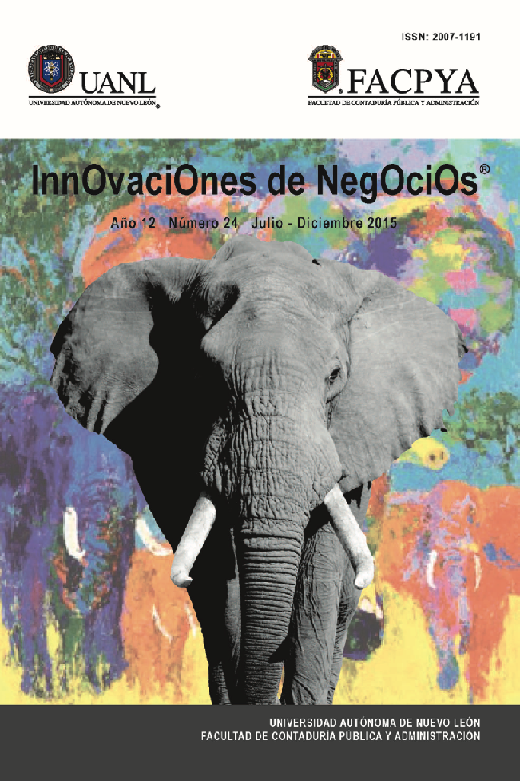The principles of diversity and geographical proximity in an industrial ecosystem: social network analysis in the Toluca- Lerma region
DOI:
https://doi.org/10.29105/rinn12.24-1Keywords:
industrial ecosystems, industrial symbiosis, residues, social network analysis, wastesAbstract
Industrial ecology allows the traditional model of industrial activity, where individual manufacturing process that takes raw materials in order to generate products, to be transformed into a more comprehensive model of a regional economy named industrial ecosystem. This ecosystem functions through industrial symbiosis alliances formed by firms that cooperate through the exchange of residues in order to use them as inputs to transform them into valuable products. Moreover, the principles of geographical proximity and diversity of the firms have been found in successful ecosystems in developed countries. This study contributes empirically by using social network analysis (SNA) methods to explore, the presence of these two principles in an industrial ecosystem in the Toluca-Lerma region in Mexico, consisting of 30 firms that have industrial symbiosis alliances. We conclude that in the context of developing countries, the symbiotic exchanges may not be fully explained with the principles of geographical proximity and diversity.
Downloads
References
Al-Khatib, I. A., Kontogianni, S., Nabaa, H. A., & Al-Sari, M. I. (2014). Public perception of hazardousness caused by current trends of municipal solid waste management. Waste Management, 36, 323–330.
Aldrich, H. E., & Auster, E. (1986). Even dwarfs started small: Liabilities of size and age and their strategic implications. Research in Organizational Behavior, 8, 165-198.
Ashton, W. (2008). Understanding the organization of industrial ecosystems: A social network approach. Journal of Industrial Ecology, 12(1), 34-51.
Belussi, F. & Gottardi, G. Eds. (2000). Evolutionary patterns of local industrial systems. Aldershot, U.K.: Ashgate Publishing Company.
Boons, F. & Spekkink, W. (2012). Levels of institutional capacity and actor expectations about industrial symbiosis. Journal of Industrial Ecology, 16(1), 61-69.
Borgatti, S. P., Everett, M. G. & Freeman, L. C. (2002). Ucinet for Windows: Software for social network analysis 6. Harvard, MA: Analytic Technologies.
Borgatti, S. P. & Li, X. (2009). On social network analysis in a supply chain context. Journal of Supply Chain Management, 45(2), 5-21.
Bryman, A. (1984). The debate about quantitative and qualitative research: A question of method or epistemology? The British Journal of Sociology, 35(1), 75-92.
Carter, C. R., Ellram, L.M. & Tate, W. (2007). The use of social network analysis in logistics research. Journal of Business Logistics, 28(1), 137-169.
Chertow, M. R. (2000). Industrial symbiosis: Literature and taxonomy. Annual Review of Energy and Environment, 25(1), 313–337.
Chertow, M. R., Ashton, W. & Espinosa, J.C. (2008). Industrial symbiosis in Puerto Rico: Environmentally related agglomeration economies. Regional studies, 42(10), 1299-1312.
Chertow, M. R. (2007). Uncovering Industrial Symbiosis. Journal of Industrial Ecology, 11(1) , 11-31.
Chertow, M. R. & Lombardi, D.R. (2005). Quantifying economic and environmental benefits of co-located firms. Environmental Science & Technology, 39(17), 6535-6541.
Corder, G. D. (2005). Potential synergy opportunities in the Gladstone Industrial Region. Perth, WA, Australia: Centre for Sustainable Resource Processing (CSRP).
Dekker, D., Krackhardt, D., & Snijders, T. A. B. (2003). Multicollinearity robust QAP for multiple regression. Paper presented at the NAACSOS conference, Omni William
Penn, Pittsburgh.
Ehrenfeld, J. R. & Chertow, M.R. (2002). Industrial symbiosis: The legacy of Kalundborg. In R.U. Ayres & L. Ayres (Eds.), Handbook of Industrial Ecology (pp. 334-348).
Cheltenham, U.K: Edward Elgar Publishing Erkman, S. & Ramaswamy, R. (2003). Applied industrial ecology: A new platform for planning sustainable societies. Bangalore, India: Aicra Publishers.
Erkman, S. (1997). Industrial ecology: An historical view. Journal of Cleaner Production, 5(2),1-10.
Fiegenbaum, A., & Karnani, A. (1991). Output flexibility - A competitive advantage for small firms. Strategic Management Journal, 12(2), 101-114.
Frosch, R. A. (1992). Industrial ecology: A philosophical introduction. Proceedings of the national academy of sciences, 89(3), 800-803.
Frosch, R.A. & Gallopoulos, N. E. (1989). Strategies for manufacturing. Scientific American, 261(3), 144-152.
Geng, Y. & Cote, R. (2007). Diversity in industrial ecosystems. Journal of Sustainable Development and World Ecology, 14(2), 329-335
Gertler, N., & Ehrenfeld, J. R. (1996). A down-to earth approach to clean production. Technology Review, 99(2), 48-54.
Gibbs, D. & Deutz, P. (2005). Implementing industrial ecology? Planning for eco-industrial parks in the USA, Geoforum, 36(4), 452–464.
Graedel, T. E. (1996). On the concept of industrial ecology. Annual Review of Energy and the Environment, 21(1), 69-98.
Harrison, B., Kelley, M. R. & Gant, J. (1996). Innovative firm behavior and local milieu:Exploring the intersection of agglomeration, firm effects, and technological change.
Economic Geography, 72(3), 233-258.
Hitt, M. A., Hoskisson, R. E., & Harrison, J. S. (1991). Strategic competitiveness in the 1990s:Challenges and opportunities for U.S. executives. Academy of Management Executive, 5(2), 7-22.
Hobday, M. (2005). Firm-level innovation models: Perspectives on research in developed and developing countries. Technology Analysis & Strategic Management, 17(2), 121-146.
Jackson, T. & Clift, R. (1998). Where’s the profit in industrial ecology?. Journal of Industrial Ecology, 2(1), 3-5.
Jacobs, J. (2002). The nature of economies. Vintage Books
Jacobsen, N. B. (2006). Industrial symbiosis in Kalundborg, Denmark: a quantitative assessment of economic and environmental aspects. Journal of Industrial Ecology,
(1-2), 239-255.
Johnson, R., B., Onwuegbuzie, A., J. & Turner, L. A. (2007). Toward a definition of mixed methods research. Journal of Mixed Methods Research, 1(2), 112-133.
Katz, R. L. (1970). Cases and concepts in corporate strategy. Englewood Cliffs, NJ: Prentice Hall.
Keoleian, G. A. & Garner, W. A. (1994). Industrial ecology: An introduction. National Pollution Prevention Center, University of Michigan.
Kim, Y., Choi, T.Y., Yan, T. & Dooley, K. (2011). Structural investigation of supply networks: A social network analysis approach. Journal of Operations Management, 29(3), 194-211.
Korhonen, J. (2001a). Some suggestions for regional industrial ecosystems: extended industrial ecology. Eco-Management and Auditing, 8(1), 57–69.
Korhonen, J. (2001b). Regional industrial ecology: examples from regional economic systems of forest industry and energy supply in Finland. Journal of Environmental
Management, 63(4), 367–375.
Korhonen, J. (2005). Theory of industrial ecology: The case of the concept of diversity. Progress in Industrial Ecology, 2(1), 35-72.
Korhonen, J., Wihersaari, M. & Savolainen, I. (1999). Industrial ecology of a regional energy supply system: The case of Jyvaskyla Region. Journal of Greener Management International, 26, 57-67.
Laurent, A., Bakas, I., Clavreul, J., Bernstad, A., Niero, M., Gentil, E., & Christensen, T. H. (2014). Review of LCA studies of solid waste management systems–Part I:Lessons learned and perspectives. Waste management, 34(3), 573-588.
Leonard, A. (2010). The story of stuff: How our obsession with stuff is trashing the planet. N.Y., USA: The Free Press.
Lewin, A. Y. & Massini, S. (2003). Knowledge creation and organizational capabilities of innovating and imitating firms. In Tsoukas, H. and Mylonopoulos (Eds.),
Organizations as Knowledge Systems, New York: Palgrave, 209-237
Lowe, E. A. & Evans, L. K. (1995). Industrial ecology and industrial ecosystems. Journal of Cleaner Production, 3(1), 47-53.
MacMillan, I. C., Hambrick, D. C., & Day, D. L. (1982). The product portfolio and profitability-A PIMS-based analysis of industrial-product businesses. Academy of Management Journal, 25(4), 733-755.
McMahon, S. M., Miller, K. H. & Drake, J. (2001). Networking tips for social scientists and ecologists. Science, 293(5535), 1604-1605.
Mirata, M. (2004). Experiences from early stages of a national industrial symbiosis programme in the UK: Determinants and coordination challenges. Journal of Cleaner Production, 12(8), 967-983.
Mirata, M. & Emtairah, T. (2005). Industrial symbiosis networks and the contribution to environmental innovation: The case of the Landskrona industrial symbiosis programme. Journal of Cleaner Production, 13(10), 993-1002.
Norohna, J. (1999). Scavenger and decomposers in an industrial park system: A case study of Burnside industrial park (Master theses). Dalhousie University, Halifax Nova Scotia.
Pauli, G. (2010). Blue economy: 10 years, 100 innovations, 100 million jobs. New Mexico, USA: Paradigm Publications.
Porter, M. E. (1998). Clusters and competition: New agendas for companies, governments, and institutions on competition. Harvard Business School, 197-287.
Randjelovic, J., O'Rourke, A. R., & Orsato, R. J. (2003). The emergence of green venture capital. Business Strategy and the Environment, 12(4), 240-253.
Rogers, M. (2004). Networks, firm size and innovation, Small Business Economics, 22(2),141-153.
Schick, H., Marxen, S., & Freimann, J. (2002). Sustainability issues for start-up entrepreneurs. Greener Management International, 2002(38), 56-70.
Seuring, S. (2004). Industrial ecology, life cycles, supply chains: differences and interrelations. Business strategy and the Environment, 13(5), 306-319.
Stevenson, W. B. & Greenberg, D. (2000). Agency and social networks: Strategies of action in a social structure of position, opposition, and opportunity. Administrative Science
Quarterly, 45(4), 651-678.
Suh, S. & Kagawa, S. (2005). Industrial ecology and input-output economics: An introduction. Economic Systems Research 17(4), 349–364.
Tsai, W. (2002). Social structure of coopetition within a multiunit organization: Coordination, competition, and Intraorganizational knowledge sharing. Organization Science, 13(2), 179-190.
Van Beers, D., Corder, G., Bossikov, A, & van Berkel, R. (2007). Industrial symbiosis in the Australian minerals industry: The cases of Kwinana and Gladstone. Journal of Industrial Ecology, 11(1), 55- 72
Van Dijk, B.; Den Hertog, R., Menkveld, B. & Thurik, R. (1997). Some new evidence on the determinants of large- and small-firm innovation. Small Business Economics, 9(4),335-343.
Wright, R.A. (2007). Exploring an ecological analogy: Testing connectance and diversity concepts for use in industrial ecology (Doctoral dissertation theses). Retrieved from Proquest Dissertations & Theses.
Yay, A. S. E. (in press). Application of life cycle assessment (LCA) for municipal solid waste management: a case study of Sakarya. Journal of Cleaner Production.
Yin, R. K. (2009). Case study research: design and methods (4th Ed.). California, USA: Sage Publications.
Zhu, O., Lowe, E. A., Wei, Y. & Barnes, D. (2007). Industrial symbiosis in China: A case study of the Guitang Group. Journal of Industrial Ecology, 11(1), 31-42.
Downloads
Published
How to Cite
Issue
Section
License
Copyright (c) 2017 Innovaciones de Negocios

This work is licensed under a Creative Commons Attribution-NonCommercial-ShareAlike 4.0 International License.
The InnOvaciOnes de NegOciOs magazine is a free and open access electronic magazine of a scientific-academic nature and is a publication of the Autonomous University of Nuevo León, in which the authors retain their copyright and grant the magazine the exclusive right to first publication of the work. Third parties are allowed to use the published content, as long as the authorship of the work is acknowledged and the first publication in this journal is cited.
For more information, please contact the Research Secretary (FACPyA) of the Autonomous University of Nuevo León. Telephone: (81) 1340-4430. Email: revinnova@uanl.mx










